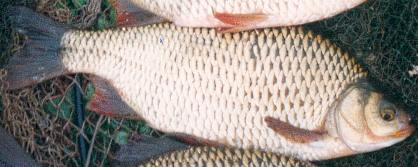Although they are widespread in many parts of Europe, British rudd used to be largely restricted to lakes and slow-moving rivers in the south-east. Their transfer elsewhere has given anglers the opportunity to catch this beautiful and interesting fish.

Colour me pretty
To the inexperienced eye, rudd and roach appear similar, but the recognition of true rudd is really quite easy. The mouth is angled steeply upwards; the leading edge of the dorsal fin is behind the base of the pelvic fins; and there is a well-developed keel between the pelvic fins and the anus. Characteristically, each eye has a deep yellow iris, with a red spot just above it.
Small rudd tend to be quite silvery in appearance, with greeny-brown backs, but their flanks take on a beautiful bronze/yellow hue as the fish grow larger and develop a somewhat hump-backed appearance. The paired fins are usually tinged red, sometimes in an intense, blood-red colour.
Loose morals
Rudd display a remarkable lack of faithfulness at spawning time, and they readily hybridise with roach, bronze and silver bream, and even bleak. Rudd-roach hybrids, in particular, may not necessarily exhibit ‘half-and-half’ external characteristics, and more than one potential record rudd has later been identified as a hybrid. Sadly, accurate differentiation can be carried out only after killing the fish and examining the pharyngeal (or throat) teeth or the make-up of the body proteins.
The species has a propensity to breed successfully in large numbers, and this can cause fisheries to become populated by ‘stunted’, sprat-sized fish. At young ages, the diet of rudd comprises water plants, insect larvae and freshwater crustaceans, as well as surface insects for which their upturned mouths are so well adapted. Large fish also feed on water snails and even small fish.
In decline
In recent years, evidence has come to light which indicates that rudd are becoming eradicated from many of our fIsheries. Some scientists have speculated that this may be a consequence of adverse competition by roach; others have suggested that the lack of submerged water plants in coloured, algal-rich water may be depriving adult rudd of spawning sites or the newly emerged rudd fry of the water plants on which attach themselves for a week or so after hatching.
–*–
If you are interested in cheap rudd fishing tackle and bait, please click here.




















